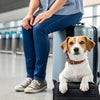What is the Max Weight for a Dog to Fly? A Comprehensive Guide for Pet Owners
- Houndsy
Table of Contents
- Introduction
- Understanding Airline Weight Limits for Dogs
- Preparing Your Dog for Air Travel
- Tips for a Smooth Flight Experience
- What to Expect at the Airport
- Conclusion
- FAQ
Introduction
Did you know that over 2 million pets are transported by air each year in the United States alone? As pet lovers, we understand how much our furry companions mean to us, and traveling with them can be a delightful experience if done right. However, when it comes to flying with our dogs, understanding the weight limits and regulations is crucial for ensuring a smooth journey.
In this blog post, we will explore everything you need to know about flying with your dog, particularly focusing on the maximum weight restrictions imposed by various airlines. We’ll also discuss the nuances of traveling with large and small breeds, the requirements for pet carriers, and practical tips to ensure your dog's safety and comfort during the flight. By the end of this article, you will have a clear understanding of the max weight for a dog to fly and how to prepare for this adventure.
So, whether you're planning a short domestic trip or an international getaway, let’s dive into the specifics of flying with your four-legged friend!
Understanding Airline Weight Limits for Dogs
When it comes to flying with dogs, the maximum weight limit can vary significantly based on several factors, including the airline, the type of travel (in-cabin or cargo), and the specific breed of your dog.
In-Cabin vs. Cargo Travel
- In-Cabin Travel: Most airlines allow small dogs to travel in the cabin with their owners, provided they can fit comfortably in an airline-approved carrier that fits under the seat in front of you. Generally, this weight limit is around 15-20 pounds, but you should always check with your specific airline for their exact requirements.
- Cargo Travel: For larger dogs that cannot fit in a carrier under the seat, they must travel in the cargo hold. The weight limit for dogs traveling in cargo is usually higher, often exceeding 50 pounds, but the combined weight of the dog and the kennel must not exceed the airline's specified limit, which can vary.
Typical Airline Weight Limits
Here are some examples of common airline weight limits for dogs traveling in-cabin versus as cargo:
In-Cabin Weight Limits
- American Airlines: Up to 20 pounds (including carrier weight)
- Delta Airlines: Typically up to 15-20 pounds (varies by aircraft)
- Southwest Airlines: Up to 20 pounds (including carrier weight)
- United Airlines: Generally allows dogs up to 20 pounds in the cabin
Cargo Weight Limits
- American Airlines: Pets and kennels combined should not exceed 150 pounds.
- Delta Airlines: Pets traveling as cargo typically must not exceed 150 pounds in total weight.
- United Airlines: Similar weight limits apply, typically capped at around 150 pounds for dogs and kennels.
Special Considerations for Breed
Some breeds, particularly brachycephalic (short-nosed) dogs, may not be allowed to fly due to their increased risk of respiratory problems at high altitudes. It's essential to check with your airline regarding breed-specific restrictions and health requirements.
Preparing Your Dog for Air Travel
Preparation is key when flying with your dog, especially as we navigate the various weight limits and regulations that differ by airline. Here are some steps to take to ensure your pet is ready for the trip.
Visit the Veterinarian
Before flying, it’s important to ensure your dog is healthy enough for air travel. Schedule a visit to the veterinarian to:
- Obtain a health certificate, which some airlines require.
- Discuss any breed-specific concerns, especially if your dog is a brachycephalic breed.
- Ensure your dog is up to date on vaccinations, as some destinations may have specific requirements.
Choose the Right Carrier
Selecting an appropriate carrier is crucial for your dog's comfort and compliance with airline regulations. Here are some tips:
- Size Matters: Make sure your dog can stand, turn around, and lie down comfortably in their carrier. The carrier should also fit under the seat in front of you.
- Ventilation: Choose a carrier that has sufficient ventilation on multiple sides.
- Secure Closure: Ensure the carrier has secure latches to prevent escape.
Acclimate Your Dog to the Carrier
Familiarizing your dog with the carrier before the trip can reduce anxiety. Here’s how:
- Let them explore the carrier at home.
- Use treats and praise to create positive associations with the carrier.
- Practice short trips in the carrier to get your dog accustomed to being confined.
Tips for a Smooth Flight Experience
Flying with your dog can be stressful, so here are some tips to make the experience as pleasant as possible for both you and your furry friend.
Book Early and Confirm Space
When booking your flight, make sure to:
- Reserve your dog’s spot early, as airlines often limit the number of pets allowed in the cabin.
- Confirm the airline’s pet policy and any specific requirements for your breed.
Avoid Extreme Weather Conditions
Be mindful of the weather when planning your travel dates:
- Summer: Choose early morning or late evening flights to avoid the heat.
- Winter: Midday flights are generally best to avoid extreme cold.
Pack Essentials
Make sure to pack the following items for your dog:
- Food and water (include a collapsible bowl)
- Leash and harness
- Waste bags
- A familiar blanket or toy to provide comfort
What to Expect at the Airport
Traveling through the airport can be hectic, so here’s what to anticipate.
Check-In Procedures
Upon arriving at the airport:
- Go to the airline’s designated pet check-in counter.
- Present any required documentation, such as health certificates.
- Make sure your dog is secured in their carrier before proceeding through security.
TSA Screening
At security, you may be required to remove your dog from their carrier and carry them through the screening area. Ensure your dog is leashed and calm during this process.
Pet Relief Areas
Most airports have designated pet relief areas. Make sure to take your dog to relieve themselves before boarding the flight.
Conclusion
Flying with your dog doesn’t have to be a stressful experience. By understanding the maximum weight limits for flying, preparing adequately, and choosing the right airline, you can make the journey enjoyable for both you and your furry companion.
As you plan your next trip, consider how the Houndsy Kibble Dispenser can simplify your dog-feeding routine on the go. With its innovative design and reliable portion control, you can ensure your pet is well-fed and happy, no matter where your travels take you. Order your Houndsy Kibble Dispenser now!
FAQ
Q: Can I bring my dog in the cabin for free?
A: Most airlines charge a fee for pets traveling in the cabin, which can range from $95 to $150, depending on the airline.
Q: What is the maximum weight for a dog to fly in the cabin?
A: Typically, the maximum weight limit for dogs flying in-cabin ranges from 15 to 20 pounds, including the weight of the carrier.
Q: Are there restrictions for certain breeds?
A: Yes, some airlines have restrictions on brachycephalic breeds due to their respiratory issues. Always check with the airline regarding their specific policies.
Q: What should I do if my dog is too large to fly in the cabin?
A: If your dog exceeds the weight limit for in-cabin travel, they will need to be transported in the cargo hold. Ensure their crate meets airline requirements for cargo travel.
Q: How can I help my dog adjust to flying?
A: Familiarize your dog with their carrier, take them on short car rides, and ensure they are comfortable with new environments to help them adjust to flying.
By taking these considerations to heart and preparing in advance, you can ensure that your travels with your dog are as smooth and enjoyable as possible. Safe travels!












